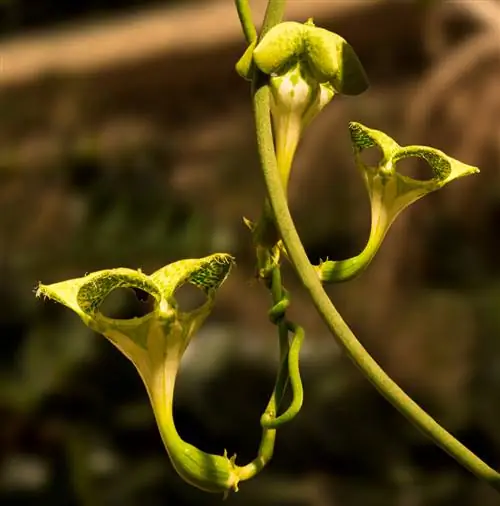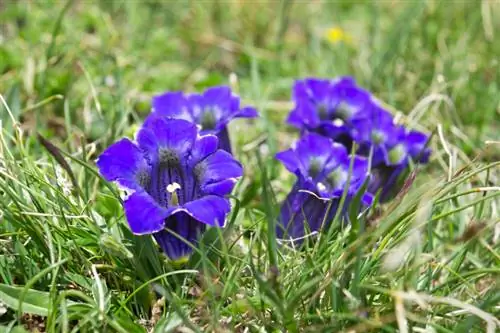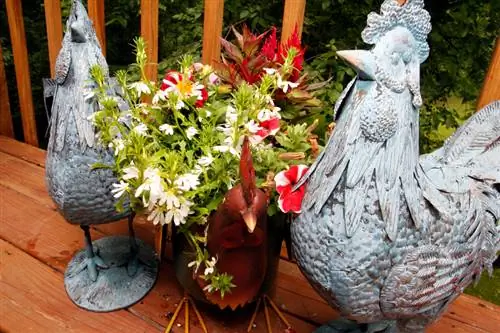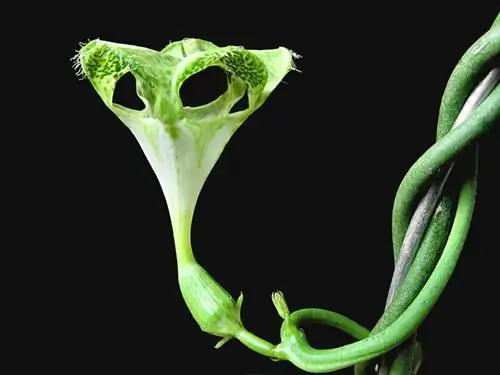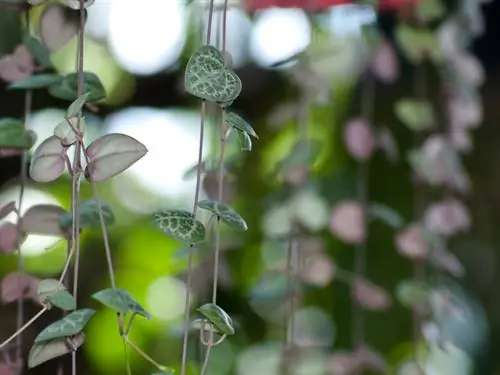- Author admin [email protected].
- Public 2023-12-25 17:45.
- Last modified 2025-01-23 11:21.
Candlestick flowers have developed flower shapes that are incomparable to any other flower in their complexity. Due to their specialization in environmental conditions, the plants hardly require any care. When it comes to choosing a location and substrate, you need to consider a few factors to make candlestick flowers feel comfortable.
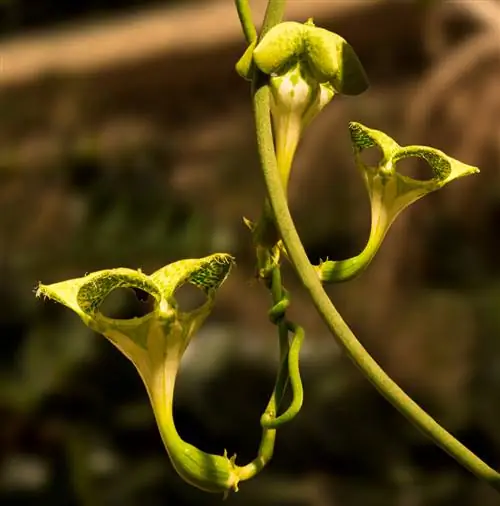
How do I properly care for a candlestick flower?
Candlestick flowers (Ceropegia) are attractive, easy-care plants with showy, lantern-shaped flowers. They prefer bright locations without direct sunlight, nutrient-poor substrate and moderate watering. Ideal as hanging basket plants, they can be propagated by bulbs, seeds or cuttings.
Origin
Both the plant genus Ceropegia and the species Ceropegia linearis subsp. are used as candlestick flowers. called woodii. It is a popular ornamental plant and is also sold under the name Ceropegia woodii. Candlestick flowers belong to the dog poison family. The natural distribution area of the subspecies cultivated as an ornamental plant is limited to the subtropical regions of South Africa. Other subspecies of Ceropegia linearis also occur in Mozambique, Zimbabwe and Malawi as far as Kenya in the north of the continent.
leaves
Ceropegia woodii has fleshy, thickened leaves that serve as water reservoirs. These succulent leaves are divided into a lanceolate to heart-shaped leaf blade and a three to ten millimeter long petiole. The leaves can be more or less round. The blade is pointed at the end and colored dark green on the upper side. The underside of the leaves appears light green and often has a red tinge. The small leaves sit opposite each other on the shoot and have a high decorative value due to their silvery-white grain.
Bloom
The candlestick flower owes its name to the strikingly shaped flowers. These are hermaphroditic and have an axis of symmetry. Each flower reaches a length of between two and 2.5 centimeters. Their petals are fused together and form a corolla, which merges into the corolla tube with a visible constriction. The crown cauldron is spherical to oval in shape and about four millimeters wide. The crown tube has a diameter of two millimeters.
Flower color
While the corolla is colored greenish-white to whitish-purple with a dark purple vein, the corolla tube appears light purple or purple-striped. It often has whitish dots or a net-like structure at the upper end. Their light green to purple corolla lobes curve inwards. They are fused together at their tip like an umbrella.
Flower Ecology
The flower anatomy is reminiscent of small lampshades. Candlestick flowers have a special purpose with this flower shape. They give off a smell that attracts small flies. These get lost in the corolla tube, in which they are trapped by the small hairs. The flies pollinate the first mature female flower organs with the pollen packets they bring with them. The male organs then mature and produce new pollen, which the flies ingest through their movements in the flower. The hairs in the flower throat relax so that the flies can escape again.
Growth
Ceropegia woodii develops root tubers that are spherical, thickened and have a rough surface. As the rootstock gets older, it becomes stronger and stronger. They sprout twining, creeping or hanging shoot axes that can reach a length of 100 centimeters. They are very thin with a diameter of between one and two millimeters. Older specimens form small white nodules in the leaf axils, which are used for vegetative propagation.
Usage
Candlestick flowers are ideal hanging plants. The green curtain of shoots and leaves is an interesting eye-catcher in hanging pots. But tall vessels such as vases, old copper jugs or zinc tubs are also perfect for creating green plant arrangements with the candlestick flower. The shoots of the succulent plant can be shaped as desired. You can grow the plant in a heart shape or as a trellis. Use flexible wires to guide the rung in the right direction.
Is candlestick poisonous?
There is no known information about possible toxic ingredients. The candlestick flower produces a transparent to whitish milky sap in the root tuber and plant parts, which is considered harmless. As a precaution, sensitive people should carry out care procedures using gloves to prevent possible skin reactions. There is also no known danger to animals from consuming the plant.
Many dog poison plants, including the candlestick flower, are poisonous and should not be cultivated within the reach of children and pets. If you choose this plant, it should be placed in inaccessible places as a precaution. Note that the shoots can grow very long. The hanging stems pose a potential danger for cats, who can get caught in them while playing and tear the bucket down.read more
Which location is suitable?
Give the candlestick flower a bright location where there is a normal room temperature. Avoid places that are in the blazing sun. The succulent plants react sensitively to direct sunlight, especially in the midday hours. Flower development is supported if the plant receives some sun in the morning and evening hours. Candlestick flowers do not require any special humidity. They thrive even in dry air. In summer, the plant appreciates being placed outdoors.
What soil does the plant need?
Ceropegia woodii prefers a nutrient-poor and highly permeable substrate. For greater permeability, you can mix 60 percent soil with 40 percent loose mineral material. Small beads made of expanded clay, sand and perlite, pumice gravel or lava granules are suitable for this. These mineral admixtures ensure better air circulation as they increase the crumb structure of the substrate. They also store nutrients and moisture, which they gradually release into the substrate.
This substrate is suitable for cultivation:
- Cactus soil
- potted plant soil
- Picking Earth
Propagate candlestick flower
The easiest way to propagate candlestick flowers is via their brood nodules, which form in the leaf axils. This propagation variant is possible during the main growth phase from spring to autumn. Pick off the nodules and sprinkle them on a suitable substrate. Cover the nodules with a layer of quartz sand to prevent rot. Place the pot in a shady place where the temperatures are between 16 and 18 degrees Celsius. Make sure the soil moisture is constant.read more
Sowing
If your plant has developed fruits, you can use the seeds inside for propagation. Fill a plastic pot with a suitable growing substrate, which you loosen up with mineral additives. Distribute the seeds evenly over the soil and cover larger seeds lightly with substrate. Small seeds can be exposed.
Put a transparent plastic bag or foil over the pot to keep the humidity constant. To prevent mold formation, you should consider daily ventilation. Take this opportunity to add some fresh water to the substrate.
The seeds germinate at this location:
- partly shaded on the windowsill or in the mini greenhouse
- Temperatures between 23 and 28 degrees Celsius during the day
- 20 to 22 degrees Celsius is ideal at night
Cuttings
Cut shoots between eight and ten centimeters long from the plant and let the cuts air dry for a few days. Remove the lowest leaves and place the shoots in a sandy substrate.
The cuttings feel comfortable in slightly moist soil. Water sparingly and allow the top layer to dry between watering sessions. The location should be bright and ensure temperatures between 16 and 18 degrees Celsius. After seven to eight weeks the first roots have developed.
Candlestick flower in pot
Choose a container that offers enough space for the roots. Candlestick flowers thrive better in shallow pots than in deep containers. When choosing, you should make sure that the pot offers enough space for drainage. It should have a drainage hole so that the water can drain away. Cover the bottom with shards of pottery and then fill the container with substrate.
Ceropegia woodii develops a fine root system on which numerous nodules are formed. These thickenings not only serve as water and nutrient storage, but also take on photosynthesis functions. The roots need some light to convert energy. Cover the root system lightly with a sandy layer that should not be more than one centimeter thick.
Balcony
During the summer months you can place the candlestick flower on the balcony or terrace without any worries. A spot in partial shade is ideal because the leaves are sensitive to direct sunlight.
Watering candlestick flower
Candlestick flowers are specialists when it comes to water supply. They store moisture in their thickened plant parts and draw on these reserves in dry times. You only need to water your candlestick flower moderately. Allow the soil to dry between watering sessions. The plant cannot tolerate waterlogging. Pour out the excess water in the coaster after five minutes at the latest.
Watering candlestick flowers in winter
Reduce watering to a minimum during the dormant phase so that the root ball cannot dry out. Orientate yourself to the room temperature of the winter quarters. The cooler it is, the less often you have to water the plant. Rainwater is suitable for watering. Candlestick flowers are content with tap water as long as it is not too hard.
Fertilize the candlestick flower properly
Fertilize the plant sparingly as its nutrient requirements are low. Mature and he althy plants receive fertilization every four weeks between spring and autumn. Cactus fertilizer is a good source of nutrients and is administered in low concentrations with the irrigation water. When the candlestick flower goes dormant in winter, you no longer need to fertilize the plant.
Cut the candlestick flower correctly
Candelabra flowers can be cut all year round if the shoots become too long. Larger cuts should be carried out in spring so that the plant can regenerate quickly. Severe pruning causes the plant to develop numerous new shoots. This encourages the breeding tubers to sprout.
How do I transplant correctly?
As soon as the roots have spread throughout the pot, you should transplant the candlestick flower. Young plants need a few years until the space becomes too small. You can repot older plants annually. The best time for this measure is spring, shortly before the end of winter rest.
Wintering
From November the candlestick flower goes into hibernation, which lasts until February. The succulent plant likes to spend the winter in a cooler place in the house. Place the bucket in an unheated stairwell or in a rarely used room. Temperatures should be between 12 and 18 degrees Celsius. If the thermometer drops below eight degrees Celsius, the candlestick flower can be damaged.
The cold period is important so that the plant develops flowers next spring. During this time you should reduce care measures to a minimum.
Diseases
Candlestick flowers are robust plants that are rarely weakened by diseases. Frequent damage is caused by care errors. Waterlogging is the plant's biggest enemy because it leads to root rot. If this factor is not recognized quickly enough, the plant can die.
Fungal infestation
If the leaves suddenly wilt or turn a pale green color, an infestation by fungi of the Phytophthora genus may be the cause. These fungi are considered aggressive opportunistic parasites. If they have settled on a host plant, it usually does not survive the infection. You should remove the infected plant so that the fungus does not spread to other plants in the area.
Phytophthora colonizes putrid parts of plants. The fungi are often involved in root rot and further accelerate the rotting processes. As a preventative measure, you should make sure that the substrate does not become waterlogged. Over-fertilization also favors the living conditions of the fungal spores.
Pests
Candelion flowers are attacked by pests that feed on the sap of the plants. If the infestation is not treated in time, the plant will become increasingly weakened.
Aphids
The pests leave a sticky film on the leaves. This honeydew provides optimal growth conditions for sooty mold fungi. These fungi look unsightly but do not cause any further damage to the plant. Aphids prefer to reproduce in dry summer months. He althy plants are less susceptible to the pests. If your plant is infested, you can remove the aphids with a sharp jet of water. Neem preparations are helpful for larger pest infestations (€28.00 on Amazon).
mealybugs and mealybugs
These pests appear occasionally and leave behind white webs that resemble cotton balls. They suck out the sap and inject the plant with toxic substances that affect its growth. Affected leaves turn yellow and curl until they eventually fall off. Plants weakened by care errors are particularly susceptible to pest infestation. Place affected plants in a bright and cool place and spray the plant parts with an antidote.
Mealybug and mealybug control agents:
- 15 ml spirit
- 1 l water
- 15 ml curd soap dissolved curd soap or paraffin oil
Tip
Candlestick flowers are often offered in stores in normal peat or potting soil with a few Styrofoam beads mixed in. Replace the substrate at home with more suitable soil, as this will support he althy and strong growth.
Varieties
- Variegata: Silvery-white striped leaves with a pink edge, easy to grow. Shoots hanging, growth height up to 51 centimeters.
- Ceropegia sandersonii: Candlestick flower with climbing shoots. Flowers up to seven centimeters large, light green with white stripes and dark green speckles. Sprouts up to two meters long.

